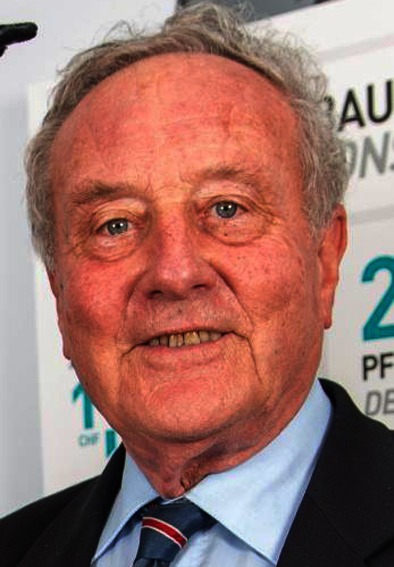The appeal of Notre Dame de Londres
In July 2009, a group of entomologists and ornithologists met at Notre Dame de Londres, a small village in the French department of Hérault, as a result of an international enquiry amongst entomologists on the catastrophic decline of insects (and arthropods in general) all over Europe.
They noted that a perceptible and gradual decline of insects, as part of the general impoverishment of the natural environment, had set in from the 1950s onwards. Amongst many others, they recognized as root causes of this decline the intensification of agriculture with its accompanying loss of natural habitats and massive use of pesticides and herbicides, the manifold increase in roads and motorized traffic as well as a continent-wide nocturnal light pollution and nitrogen deposition.
They equally agreed that a further degradation of the situation, a steeper decline in insect populations, had started in the decade 1990–2000. This first began in western Europe, followed by eastern and southern Europe, is nowadays apparent in the scarcity of insects splattered on windscreens of motorcars and squashed against their radiators and is best documented in the decline of butterflies and the global disorders amongst honey bees. They concluded that these phenomena reflected the now general collapse of Europe’s entomofauna.
They also noted that the massive collapse of different species, genera and families of arthropods coincided with the severe decline of populations of different insectivorous bird species up to now considered as “common” such as swallows and starlings.
On the basis of existing studies and numerous observations in the field as well as overwhelming circumstantial evidence, they came to the hypothesis that the new generation of pesticides, the persistent, systemic and neurotoxic neonicotinoids and fipronil, introduced in the early 1990s, are likely to be responsible at least in part for these declines.
They, therefore, issued the Appeal of Notre Dame de Londres under the heading “No Silent Spring again” referring to Rachel Carson’s book “Silent Spring” then published almost half a century ago:
The disappearance of honey bees is only the most visible part of a phenomenon now generalized in all of Western Europe. The brutal and recent collapse of insect populations is the prelude of a massive loss in biodiversity with foreseeable dramatic consequences for natural ecosytems, the human environment and public health.
The systematic use of persistent neurotoxic insecticides in intensive agriculture and horticulture (neonicotinoids such as imidacloprid and thiamethoxam, and fipronil as a phenylpyrazole), which now form an invisible, widespread, toxic haze on land, in water and in the air, is regarded as a principal cause of this collapse observed by entomologists beginning in the middle of the 1990’s and followed by the decline of insectivorous and other bird species by the ornithologists.
For this reason the undersigned raise an alarm and demand a much stricter adherence to the « Precautionary Principle » as enshrined in the E.U. Commission’s Directive 91/414, and defined by UNESCO in 2005 as « When human activities may lead to morally unacceptable harm that is scientifically plausible but uncertain, actions shall be taken to avoid or diminish that harm ».
The international scientific Task Force on Systemic Pesticides (TFSP)
In response, an international scientific Task Force on Systemic Pesticides of independent scientists was set up shortly afterwards by a Steering Committee of which Maarten Bijleveld van Lexmond (Switzerland), Pierre Goeldlin de Tiefenau (Switzerland), François Ramade (France) and Jeroen van der Sluijs (The Nederlands) were the first members. Over the years, membership grew and today counts 15 nationalities in four continents. The Task Force on Systemic Pesticides (TFSP) advises as a specialist group two IUCN Commissions, the Commission on Ecosystem Management and the Species Survival Commission. Its work has been noted by the Subsidiary Body on Scientific, Technical and Technological Advice under the Convention on Biodiversity (CBD) and was brought to the attention of the Intergovernmental Science-Policy Platform on Biodiversity and Ecosystem Services (IPBES) in the context of the fast-track thematic assessment of pollinators, pollination and food production.
In undertaking the Worldwide Integrated Assessment (WIA), over the course of the last 4 years, the TFSP has examined over 800 scientific peer-reviewed papers published over the past two decades. The TFSP areas of expertise span diverse disciplines, including chemistry, physics, biology, entomology, agronomy, zoology, risk assessment and (eco) toxicology, and this has enabled a truly interdisciplinary evaluation of the evidence, necessary to understand the diverse ramifications of the global use of systemic pesticides on individual organisms, on ecosystems and on ecosystem processes and services.
The findings of the TFSP-WIA
Neonicotinoids were introduced in the early 1990s and are now the most widely used insecticides in the world. They are neurotoxins, binding to nicotinic acetylcholine receptors (nAChRs) in the central nervous system and causing nervous stimulation at low concentrations but receptor blockage, paralysis and death at higher concentrations. Fipronil is another widely used systemic insecticide that shares many of the properties of neonicotinoids and was introduced around the same time; hence, this compound is also included here. Both neonicotinoids and fipronil exhibit extremely high toxicity to most arthropods and a lower toxicity to vertebrates (although fipronil exhibits high acute toxicity to fish and some bird species). They are relatively water soluble and are readily taken up by plant roots or leaves, so they can be applied in a variety of ways (e.g. foliar spray, soil drench and seed dressing). The predominant use of these chemicals, in terms of the area of land over which they are used, is as a seed dressing, whereby the active ingredient is applied prophylactically to seeds before sowing and is then absorbed by the growing plant and spreads throughout the plant tissues, hence protecting all parts of the crop (Simon-Delso et al. 2014).
A range of concerns have emerged as to the impacts of neonicotinoids and fipronil on the environment (Bonmatin et al. 2014; Pisa et al. 2014; Gibbons et al. 2014; Chagnon et al. 2014; Furlan and Kreutzweiser 2014):
It has become apparent that neonicotinoids can persist for years in soils and so cause environmental concentrations to build up if regularly used. This is likely to be impacting substantially on soil invertebrates, which as a group perform a vital service in maintaining soil structure and in cycling nutrients. Being water soluble, neonicotinoids leach into ponds, ditches and streams and contaminate groundwater. Contamination of marine environments has been observed but as yet has not been monitored systematically. Concentrations exceeding the LC50 for aquatic insects frequently occur in waterways, and much higher concentrations have been found in surface water in arable fields and in adjacent ditches. Waterways with higher neonicotinoid concentrations have been found to have depleted insect abundance and diversity.
Dust created during drilling of treated seeds is lethal to flying insects and has caused large-scale acute losses of honeybee colonies. When applied as foliar sprays, drift is likely to be highly toxic to non-target insects. Non-crop plants, such as those growing in field margins, hedgerows and near contaminated waterways can become contaminated with neonicotinoids either via dust created during drilling, spray drift or contaminated water. This provides the potential for major impacts on a broad range of non-target herbivorous invertebrates living in farmland.
Neonicotinoids and fipronil are found in nectar and pollen of treated crops such as maize, oilseed rape and sunflower and also in flowers of wild plants growing in farmland. They have also been detected at much higher concentrations in guttation drops exuded by many crops. In bees, consumption of such contaminated food leads to impaired learning and navigation, raised mortality, increased susceptibility to disease via impaired immune system function and reduced fecundity, and in bumblebees, there is clear evidence for colony-level effects. Studies of other pollinators are lacking. Bees in farmland are simultaneously exposed to some dozens of different agrochemicals, and some act synergistically. The impact of chronic exposure of non-target insects to these chemical cocktails is not addressed by regulatory tests and is very poorly understood.
Although vertebrates are less susceptible than arthropods, consumption of small numbers of dressed seeds offers a potential route for direct mortality in granivorous birds and mammals, for such birds need to eat only a few spilt seeds to receive a lethal dose. Lower doses lead to a range of symptoms including lethargy, reduced fecundity and impaired immune function. In addition, depletion of invertebrate food supplies is likely to indirectly impact on a broad range of predatory organisms, from arthropods to vertebrates.
The prophylactic use of broad-spectrum pesticides (as seed dressings) goes against the long-established principles of Integrated Pest Management (IPM) and against new EU directives which make adoption of IPM compulsory. Continual exposure of pests to low concentrations of neonicotinoids is very likely to lead to the evolution of resistance, as has already occurred in several important pest species. Although systemic pesticides can be highly effective at killing pests, there is clear evidence from some farming systems that current neonicotinoid use is unnecessary, providing little or no yield benefit. Agrochemical companies are at present the main source of agronomic advice available for farmers, a situation likely to lead to overuse and inappropriate use of pesticides.
Overall, a compelling body of evidence has accumulated that clearly demonstrates that the wide-scale use of these persistent, water-soluble chemicals is having widespread, chronic impacts upon global biodiversity and is likely to be having major negative effects on ecosystem services such as pollination that are vital to food security and sustainable development. There is an urgent need to reduce the use of these chemicals and to switch to sustainable methods of food production and pest control that do not further reduce global biodiversity and that do not undermine the ecosystem services upon which we all depend (van der Sluijs et al. 2014).
The systemic insecticides, neonicotinoids and fipronil, represent a new chapter in the apparent shortcomings of the regulatory pesticide review and approval process that do not fully consider the risks posed by large-scale applications of broad-spectrum insecticides to ecosystem functioning and services. Our inability to learn from past mistakes is remarkable.
Acknowledgments
This manuscript benefited from the discussions in the International Task Force on Systemic Pesticides during its plenary meetings in Paris (2010), Bath (2011), Cambridge (2012), Montegrotto-Padova (2012), Louvain-la-Neuve (2013) and Legnaro-Padova (2013). The work has been funded by the Triodos Foundation’s Support Fund for Independent Research on Bee Decline and Systemic Pesticides. This Support Fund has been created from donations by Adessium Foundation (The Netherlands), Act Beyond Trust (Japan), Utrecht University (Netherlands), Stichting Triodos Foundation (The Netherlands), Gesellschaft fuer Schmetterlingsschutz (Germany), M.A.O.C. Gravin van Bylandt Stichting (The Netherlands), Zukunft Stiftung Landwirtschaft (Germany), Study Association Storm (Student Association Environmental Sciences Utrecht University) and citizens. The funders had no role in study design, data collection and analysis, decision to publish or preparation of the manuscript.
We very much acknowledge ESPR Editor-in-Chief Philippe Garrigues and Editorial Assistant Emmanuelle Pignard-Péguet for their help during the preparation of this Special Issue.
The review process was coordinated by ESPR Editor-in-Chief, according to the strict ethical guidelines of Springer, with independent reviewers chosen by ESPR Editors.
The authors are listed in alphabetic order.
Biographies
Dr Maarten Bijleveld van Lexmond
is a biologist and conservationist by training. He studied at Leiden and Amsterdam Universities obtaining his PhD. in 1974 with the publication of his first book: Birds of Prey in Europe. As one of the founders of the World Wildlife Fund in the Netherlands he joined the WWF international secretariat in Switzerland and later led the Commission on Ecology of the International Union for the Conservation of Nature (IUCN). In the mid-eighties he founded the Swiss Tropical Gardens in Neuchâtel, now in Kerzers (Switzerland), in parallel with the Shipstern Nature Reserve in Belize, Central America. For many years he also served as President of the Foundation for the Conservation of the Bearded Vulture which succeeded in reintroducing the species into the Alps and other parts of Europe. At present, dividing his time between Switzerland and the south of France most of it since 2009 is taken up by his function as Chairman of the international Task Force on Systemic Pesticides (TFSP) which now looks into the worldwide impact of these chemicals on biodiversity and ecosystems, and in particular on pollinators such as honey bees, bumble bees, butterflies, but also at suspected consequences for public health.
Dr Jean-Marc Bonmatin
is researcher for the Centre National de la Recherche Scientifique (CNRS, France). He completed his thesis in 1987 at the University of Bordeaux (Chemistry and Physics) by studying interaction mechanisms between biological membranes and peptides by various spectroscopic techniques. This was his first scientific contact with the fascinating world of bees because these peptides have included bee venom. Just after, he worked for the National Research Council of Canada (Ottawa, Canada) until 1989. Here he was interested in dynamics of cholesterol in membranes by solid state NMR. He joined the Centre de Biophysique Moléculaire late 1989 (CBM, CNRS, Orléans, France) where he started his researches on structure-activity relationships of various biomolecules by high resolution NMR. These biomolecules have in common to be toxic to their target (antibacterial, antifungal, neurotoxins from arthropods, etc.). He shares the idea that ‘knowing how it kills, gives clues on biological mechanisms and may allow saving’. From 2008 he was involved during twelve years in European programs on what is called the Colony Collapse Disorder (CCD), especially concerning analytics of pesticides in soil, water, pollen and honey, as well as concerning the finding of a virus of bee mites (Varroa destructor). He joined the Task Force on Systemic Pesticides very early and he is a member of its Steering Committee. He is also involved in risk assessments for pollinators for several public organisms, at national and international levels, such as ITSAP (French Institute of Bee and Pollination), ANSES (French Agency of Environmental and Food Safety) and the Organisation for Economic Co-operation and Development (OECD).
Dave Goulson
is Professor of Biology at the University of Sussex. He received his bachelor’s degree in biology from Oxford University, followed by a doctorate on butterfly ecology at Oxford Brookes University. Subsequently, he lectured in biology for 11 years at the University of Southampton, before moving to Stirling in 2006, and then to Sussex in 2013. Goulson works mainly on the ecology and conservation of bumble bees. He has published more than 200 scientific articles on the ecology and conservation of insects, with a particular focus on bumblebees. He is the author of Bumblebees; Their Behaviour, Ecology and Conservation, published in 2010 by Oxford University Press, and of A Sting in the Tale, a popular science book about bumble bees, published in 2013 by Jonathan Cape. Goulson founded the Bumblebee Conservation Trust in 2006, a UK-based charity which has grown to 8,000 members. For his work on bumblebee conservation he was made BBSRC Social Innovator of the year in 2010, and received the Zoological Society of London’s Marsh Award for Conservation Biology in 2013. He was also elected a Fellow of the Royal Society of Edinburgh in 2013.
Dominique Noome MSc
is currently project coordinator for the Task Force on Systemic Pesticides and conservation manager in Kasungu National Park, Malawi. Originally a veterinary epidemiologist, she studied the hematology of Kenyan cattle and economic impacts of emerging infectious diseases on livestock in the Netherlands during her MSc. After graduating as an animal health specialist at Wageningen University, she continued as an independent conservation scientist, being involved with the IUCN Commission on Ecosystem Management, and Foundation Chimbo. During this period she first got acquainted with the Task Force on Systemic Pesticides, starting with field work in 2011 which evolved into project coordinator over the years. In Malawi, where she has just concluded writing the general management plan for Kasungu National Park, she is now focused on coordination of research projects identified in the management plan. Her main areas of interest are protected areas management, more specifically wildlife health, law enforcement and strategies for ecosystem restoration. This also extends to systemic pesticide use in African countries, such as Malawi, where many knowledge gaps about the scale of use and associated impact of these substances still exist.
Contributor Information
Maarten Bijleveld van Lexmond, Email: mbvl@club-internet.fr.
Jean-Marc Bonmatin, Phone: +33238255587, Email: bonmatin@cnrs-orleans.fr.
Dave Goulson, Email: d.goulson@sussex.ac.uk.
Dominique A. Noome, Email: dominiquenoome@gmail.com
References
- Bonmatin JM, Giorio C, Girolami V, Goulson D, Kreutzweiser D, Krupke C, Liess M, Long E, Marzaro M, Mitchell EAD, Noome DA, Simon-Delso N, Tapparo A (2014) Environmental fate and exposure; neonicotinoids and fipronil. Environ Sci Pollut Res. doi:10.1007/s11356-014-3332-7 [DOI] [PMC free article] [PubMed]
- Chagnon M, Kreutzweiser DP, Mitchell EAD, Morrissey CA, Noome DA, van der Sluijs JP (2014) Risks of large scale use of systemic insecticides to ecosystem functioning and services. Environ Sci Pollut Res. doi:10.1007/s11356-014-3277-x [DOI] [PMC free article] [PubMed]
- Furlan L, Kreutzweiser DP (2014) Alternatives to Neonicotinoid insecticides for pest control: case studies in agriculture and forestry. Environ Sci Pollut Res (this issue) [DOI] [PMC free article] [PubMed]
- Gibbons D, Morrissey C, Mineau P (2014) A review of the direct and indirect effects of neonicotinoids and fipronil on vertebrate wildlife. Environ Sci Pollut Res. doi:10.1007/s11356-014-3180-5 [DOI] [PMC free article] [PubMed]
- Pisa L, Amaral-Rogers V, Belzunces LP, Bonmatin JM, Downs C, Goulson D, Kreutzweiser D, Krupke C, Liess M, McField M, Morrissey C, Noome DA, Settele J, Simon-Delso N, Stark J, van der Sluijs JP, van Dyck H, Wiemers M (2014) Effects of neonicotinoids and fipronil on non-target invertebrates. Environ Sci Pollut Res (this issue). doi:10.1007/s11356-014-3471-x [DOI] [PMC free article] [PubMed]
- Simon-Delso N, Amaral-Rogers V, Belzunces LP, Bonmatin JM, Chagnon M, Downs C, Furlan L, Gibbons DW, Giorio C, Girolami V, Goulson D, Kreutzweiser DP, Krupke C, Liess M, Long E, McField M, Mineau P, Mitchell EAD, Morrissey CA, Noome DA, Pisa L, Settele J, Stark JD, Tapparo A, van Dyck H, van Praagh J, van der Sluijs JP, Whitehorn PR and Wiemers M (2014) Systemic insecticides (neonicotinoids and fipronil): trends, uses, mode of action and metabolites. Environ SciPollut Res (this issue). doi:10.1007/s11356-014-3470-y [DOI] [PMC free article] [PubMed]
- Van der Sluijs JP, Amaral-Rogers V, Belzunces LP, Bonmatin JM, Chagnon M, Downs C, Furlan L, Gibbons DW, Giorio C, Girolami V, Goulson D, Kreutzweiser DP, Krupke C, Liess M, Long E, McField M, Mineau P, Mitchell EAD, Morrissey CA, Noome DA, Pisa L, Settele J, Simon-Delso N, Stark JD, Tapparo A, van Dyck H, van Praagh J, Whitehorn PR and Wiemers M (2014) Conclusions of the Worldwide Integrated Assessment on the risks of neonicotinoids and fipronil to biodiversity and ecosystem functioning. Environ Sci Pollut Res. doi:10.1007/s11356-014-3229-5 [DOI] [PMC free article] [PubMed]


